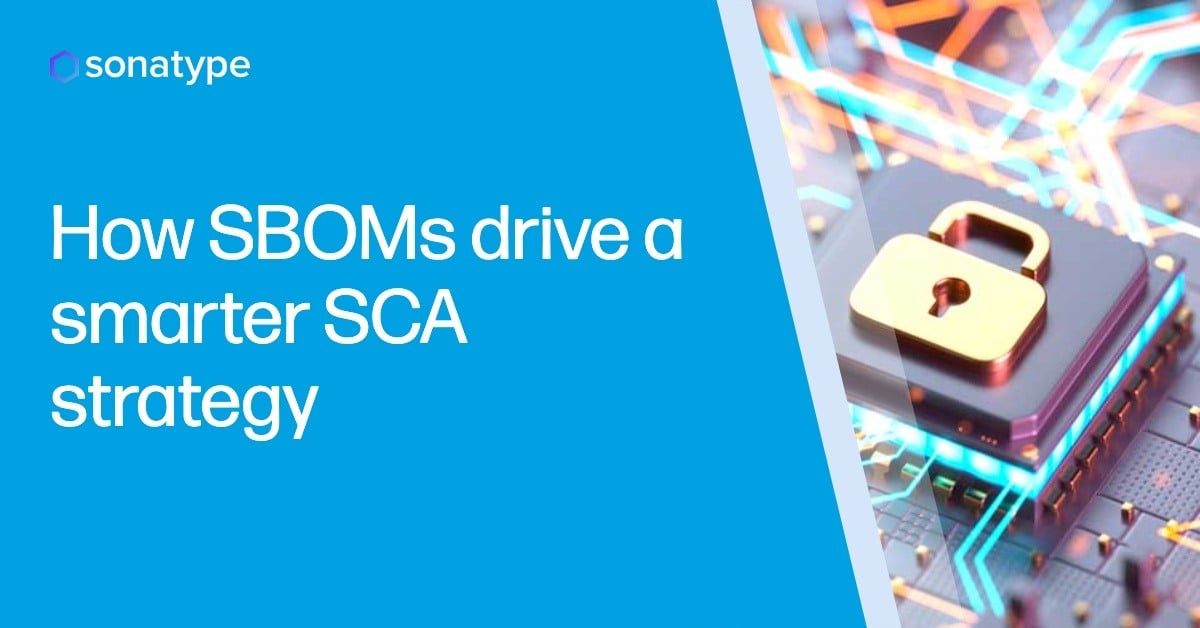How SBOMs Drive a Smarter SCA Strategy
5 minute read time

Modern software is largely assembled from open source components, constituting up to 90% of today's codebases. Managing the security and compliance risks associated with this external code is no longer optional — it's a core part of software development.
Two practices have emerged as central to this effort: software composition analysis (SCA) and the generation and management of software bills of materials (SBOMs).
While each provides unique benefits, their combined use delivers far greater value than either alone.
Understanding the Role of SCA
SCA is the process of scanning applications to identify the open source components in use and evaluating them for known security vulnerabilities, license risks, and policy violations. By embedding SCA into the software development life cycle (SDLC), organizations gain immediate visibility into the risks introduced by dependencies — often at the moment those dependencies are added.
SCA tools are optimized for active development environments. They run against build-time artifacts, alert developers to risky components, and often provide automated remediation guidance or even auto-generated pull requests. This focus on shift-left security helps development teams avoid costly delays later in the release cycle by addressing vulnerabilities early and consistently.
The Expanding Importance of SBOMs
An SBOM takes the concept of software transparency a step further. An SBOM is a machine-readable inventory of all components — open source and proprietary — that make up an application. When managed effectively, SBOMs allow organizations to track the evolving security posture of software long after it has been released into production.
SBOMs also serve as a critical bridge to compliance. Regulations across multiple sectors and geographies are increasingly requiring the use of SBOMs or detailed software inventories. SBOMs support these mandates by providing a snapshot of what was included in a release, the known vulnerabilities at that time, and any relevant triage or mitigation steps taken.
For example, SBOMs help organizations:
-
Maintain an auditable record of component usage at the time of release.
-
Document known vulnerabilities and their remediation or triage status.
-
Satisfy regulatory requirements from standards such as the Digital Operations Resilience Act (DORA), Payment Card Industry Data Security Standard (PCI DSS) 4.0, the Cyber Resilience Act (CRA), and FDA guidelines.
-
Communicate security posture to partners, auditors, and customers in a structured, machine-readable format.
Importantly, SBOMs are not static documents. As new vulnerabilities are discovered or old ones reclassified, SBOM management tools enable continuous monitoring of deployed software to detect whether newly disclosed risks impact previously released versions. This capability plays a central role in incident response and vulnerability disclosure obligations, especially when software is running in production or distributed to customers.
Differentiating SCA and SBOM Workflows
Although SCA and SBOMs both provide visibility into software components and vulnerabilities, their workflows serve different stages of the software life cycle. SCA is tightly integrated into the software development pipeline, supporting decisions at the point of dependency selection or during CI/CD builds. It enables remediation before code is ever released, helping teams stay ahead of zero-day disclosures or license violations.
SBOM management begins where SCA typically ends: post-release. It tracks what's in use in production environments and shipped binaries. For organizations delivering software to customers — especially those in regulated industries — SBOMs provide the formal documentation required to satisfy compliance audits and meet service-level agreements for vulnerability response.
From Transparency to Resilience
By combining SCA and SBOM practices, organizations can create an end-to-end view of their software supply chain. This unified approach is key to building more secure software without sacrificing development speed. In fact, organizations that have successfully aligned their SCA and SBOM strategies report both higher security outcomes and greater productivity.
SBOMs also enable more efficient tech stack reviews. By analyzing SBOM data across the organization, teams can identify trends such as repeated use of outdated or end-of-life components, over-reliance on certain libraries, or inconsistent use of cryptographic functions. This architectural insight supports long-term risk reduction and more strategic dependency management.
Compliance is a Catalyst, Not the End Goal
Although regulations are pushing SBOM adoption forward, the benefits go far beyond compliance checkboxes.
When implemented effectively, SBOMs provide value across multiple parts of the organization:
-
Security teams gain faster incident response capabilities and clearer insight into affected components.
-
Procurement teams gain visibility into the risk profiles of third-party software and vendor-supplied applications.
-
Legal teams can more easily assess and track license obligations tied to open source usage.
-
Developers are empowered to make better-informed decisions about the components they integrate into applications.
Used proactively, SBOMs are not just about responding to risk — they're about preventing it. By continuously monitoring for new vulnerabilities across deployed versions, organizations can maintain a more secure posture without needing to interrupt ongoing development.
Navigating the Challenges
Despite their value, many teams still face challenges in operationalizing SBOMs. The most common hurdles include automated SBOM ingestion and integration with existing workflows, generating accurate and complete SBOMs, and understanding how to act on the information they provide. These concerns underscore the importance of selecting tools that support both SCA and SBOM management and that offer automation, high-quality vulnerability data, and seamless integration with CI/CD pipelines.
SBOM formats such as SPDX and CycloneDX continue to evolve to support richer metadata, including license information, vulnerability references, and exploitability indicators. Leading tools can generate and consume both formats, ensuring organizations can share SBOMs internally and externally, regardless of ecosystem requirements.
Strengthening the Software Supply Chain
The software industry is moving toward a future where SBOMs are ubiquitous, and SCA is a fundamental development practice. Together, they form the backbone of modern software supply chain security — enabling faster remediation, stronger compliance, and greater trust in the software that powers critical infrastructure.
To learn more about how SBOMs drive SCA strategy and see real-world examples of organizations putting this into practice, watch our full webinar.

Aaron is a technical writer on Sonatype's Marketing team. He works at a crossroads of technical writing, developer advocacy, software development, and open source. He aims to get developers and non-technical collaborators to work well together via experimentation, feedback, and iteration so they ...
Explore All Posts by Aaron LinskensTags
Generate a SBOM for Rich Insights
Get actionable insights by generating a free software bill of materials (SBOM) powered by Sonatype SBOM Manager.